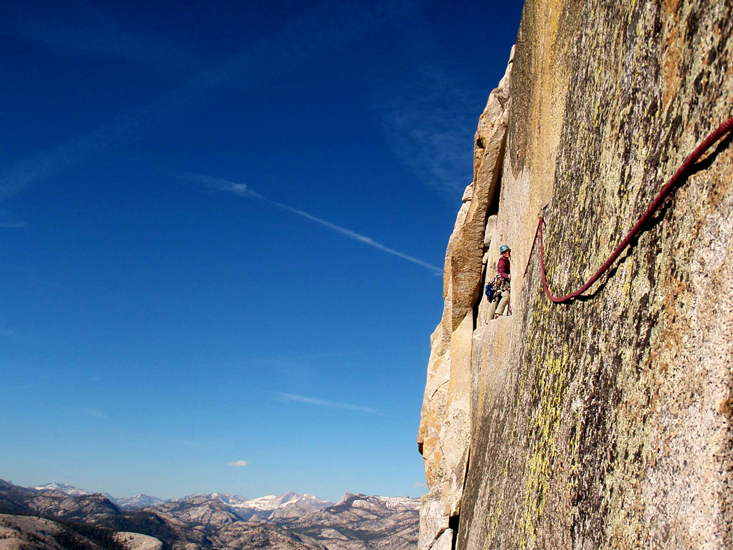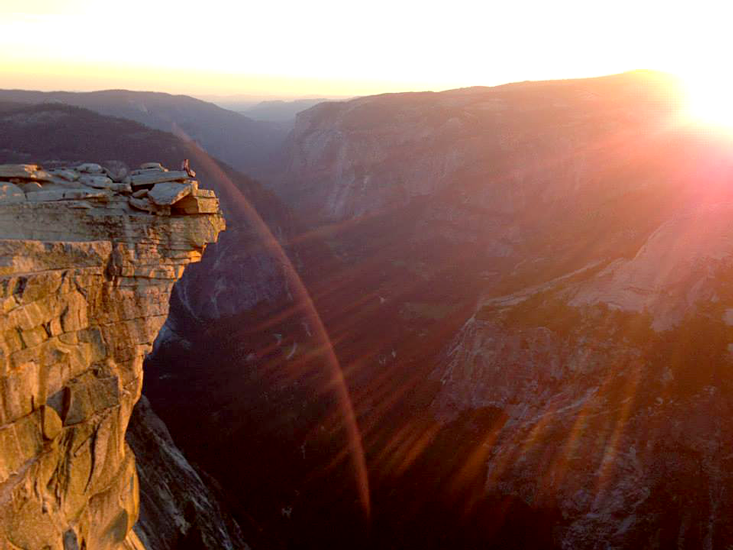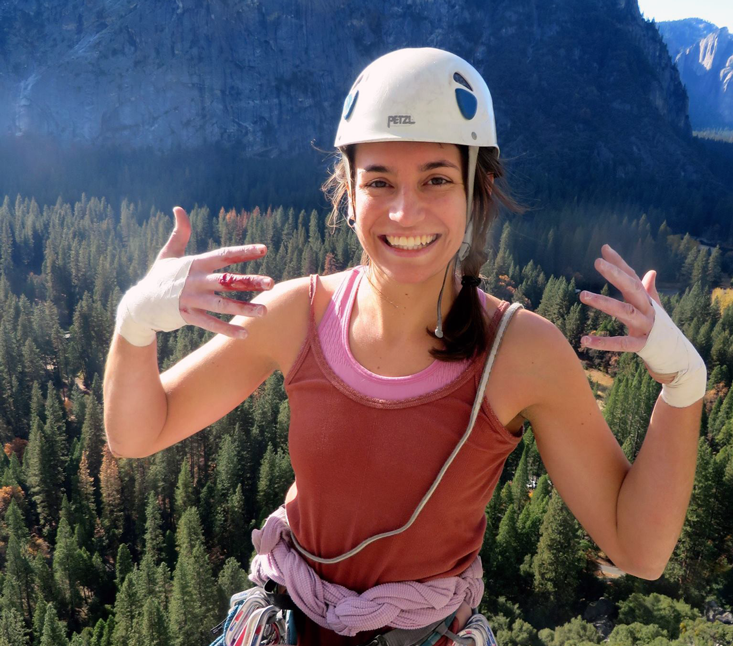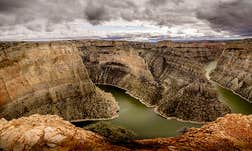We reached Thank God Ledge on the Regular Northwest Face, of Yosemite’s iconic Half Dome climb, by mid-afternoon.
This 40-foot horizontal plank-like feature is the most famous part of the route: not for its physical difficulty, but for its stomach-churning exposure. When I reached it, the ledge looked undeserving of all the hype. All I had to do, it seemed, was walk right across it. No big deal.

The first few steps were, indeed, very easy. But then the ledge narrowed, and the slab of rock against my right side bulged out, seemingly pushing me out into the abyss. Scaredy-cat that I am, I quickly found myself on my knees, and I began to crawl.
Then the ledge narrowed even more. Soon, only my right knee would fully fit on top of the ledge; my left knee precariously dangled half on the rock, and half over the empty air below. My vision narrowed, my body grew hot, my mind became fuzzy and unable to focus. I fell into a full-on panic.
“I can’t do it, Alaina!” I called out to my climbing partner.
“Yes, you can!” she immediately shouted back, in a tone closer to an order than a note of encouragement. Suddenly my whole being seemed to exist for the sole purpose of getting across that ledge. I buckled down, scurried forward, and made it to the other side. A wave of emotion that can only be described as euphoria washed over me. I let out a holler and laughed, in disbelief at what I had just done.
Desire and dread are deeply intertwined.
The best moments in climbing come when we’re right on the edge of being completely overwhelmed, but somehow, even if just barely, manage to stay on the right side of the line. The fear threatens to overwhelm us, motivating us into a state of extreme focus. It’s a state between comfort and terror, where we tap into what the University of Michigan neuroscientist Kent Berridge calls “the shimmering back and forth of desire and dread.”
Berridge, whose career has revolved around figuring out the processes that govern what we want, what we like, and what gets us going, has even isolated one location in the brain key to striking this balance. It’s called the nucleus accumbens, and it plays a role in both pleasure and terror, capable of producing either or both, depending on the circumstances. What’s more, he has observed that the response of the nucleus accumbens is flexible, operating as if it had a switch that could flip between the two emotions, even given the same trigger.
In other words, Berridge has discovered in the lab what I discovered high up on Thank God Ledge: Desire and dread are deeply intertwined.
Emotion, pleasure, motivation … they’ve been not so much understood in psychology and neuroscience over the past 50 years,” Berridge says. He has focused much of his research on the topic on the nucleus accumbens, the small area in the lower front of the brain that neuroscientists have long recognized as having a significant role in motivation, pleasure, and reward.
In the early 2000s, Berridge designed an experiment to study the neuroscience of wanting, by injecting a dopamine-like drug (a neurotransmitter that plays a large role in reward-motivated behavior) into the nucleus accumbens of lab rats. When his doctoral student, Sheila Reynolds, placed microinjections in the front of the nucleus accumbens, the rats, as expected, demonstrated strong “wanting” behavior when presented with sugar.
When Reynolds placed the microinjections in the back of the nucleus accumbens, however, the reaction was quite different. Not only did the rats not show any interest in the sugar, they became frantic. They threw sawdust in the cage (anti-predator behavior) and, when Reynolds tried to pick them up, they would try to jump out of her hand or even bite her. “Normally they’re very tame and friendly,” Berridge says. Berridge and Reynolds realized that dopamine and the nucleus accumbens might be responsible not just for desire and motivation, but also for fear.
The effect was modulated by environment, with unfamiliar environments more likely to produce fear after the injections. When the rats were moved to a lab with harsh fluorescent lighting and played Iggy Pop songs for an hour, nearly all of their responses to microinjections produced fear, regardless of where in the nucleus accumbens the injections were made. In a quiet, dark space, on the other hand, nearly all of the microinjections produced wanting behavior regardless of injection location.
The line between pleasure and fear is thin, and sometimes you can place yourself right on it.
The different behaviors were associated with different dopamine receptors, called D1 and D2. Just D1 was active in wanting behaviors in comfortable cages, but both were active in uncomfortable cages. “We think the same neurocircuit is producing both things, but it has different modes that can flip,” Berridge says. “[Dopamine is] like a little tiny sledgehammer in the brain, but it’s a changing sledgehammer each time.” What it does depends on what Berridge calls the “emotional ambience” of the animal’s environment.
As a rock climber, this fickleness of fear makes a lot of sense to me. How much fear I feel while climbing can fluctuate in seemingly mysterious ways. Sometimes, the varying nature of fear does makes sense: for example, my experience climbing with a good friend on a route that I’ve done before versus when I’m climbing with a stranger on a route that’s way too difficult for me. Other times, however, how much fear I feel seems to depend on factors less obvious to me in the present moment, like what’s going on in my non-climbing life.
But what is most interesting to me is Berridge’s interpretation of the most special climbing experience of all: When I’m able to gain control over all those other factors and a climb at my limit clicks into place, as it did on Half Dome, and feels like the most exciting thing in the world.
“It’s possible that that kind of moment on the rock is triggering, and putting [the brain] into a flip-able state,” Berridge tells me. “In some ways desire and dread are psychologically similar … It’s the same thing that’s frightening you and that’s making you love it at the same time.” The line between pleasure and fear is thin, and sometimes you can place yourself right on it.

Berridge thinks that experiencing this in-between state requires the right personal balance of safety and comfort, much like the rush of riding a rollercoaster can be desirable—so long as you’re buckled in—or how a lot of people get a kick out of seeing horror unfold—so long as they’re watching it on a screen from the couch. In a sport like rock climbing, we find that balance through practice and the development of confidence in our abilities. “If I were up there, I would be terrified,” Berridge says. “But your sense of control and confidence is much like the rats being in their homeroom.”
The in-between also has a tendency to focus you. “The world kind of brightens up, and is inviting,” Berridge says. You alternate between experiencing fear itself and the possibility of fear. It’s one way to trigger what many athletes say they are really after: the experience of flow.
Flow is a condition of intense concentration and immersion in an experience. Named and popularized by the Hungarian psychologist Mihály Csíkszentmihályi, the condition has become one of the most studied in contemporary psychology. Books have been written about how to achieve flow, and some have argued that it enables happiness, or is even necessary for happiness.
Clearly, a state of extreme fear can enable concentration and immersion. But it doesn’t allow for some of flow’s other basic requirements: a sense of personal control, and a sense of reward. Conversely, an easy athletic activity can allow for a sense of control and reward, but doesn’t require the same degree of concentration and immersion.
Adrenaline is a sign that we’re in over our heads—or that something has gone wrong.
Flow, then, seems to require a balance—like the one between fear and desire. Eric Brymer is a professor at Leeds Beckett University whose research centers on athletes who do sports like BASE jumping or free solo (ropeless) rock climbing. Brymer says it’s the committed nature of these endeavors that heightens the rewards felt by those brave and skilled enough to do them: “You’re facilitated into a state where you are right there, right then, because if you mess up there’s a good chance you’re going to die,” he says.
That’s an experience Steph Davis and Alex Honnold both know well. They are two of the most famous free solo climbers in the United States. “It’s liberating when you’re able to manage fear and do things you otherwise would have been unable to do,” Davis tells me. Honnold agrees with the premise that he free solos in order to unlock a flow-like state. “It forces you to go into that state more, because the higher consequences just demand more attention, more focus,” he says.
Brymer points out that the flow-like state achieved by the extreme athlete differs from the more traditional definition of flow, for example in the experience of time. Both types of flow, though, rely on balance in their own way. Brymer has found that most people who do extreme sports aren’t in it for the adrenaline, the hormone triggered by our innate fear response. Adrenaline is a sign that we’re in over our heads—or that something has gone wrong. Instead, the drive to put oneself into uncomfortable, scary situations is about showing mastery in the face of extreme circumstance.
But you don’t need to jump out of a plane or scale a granite wall to catch a glimpse of these sorts of expansive experiences. Finding that sweet spot of the right amount of fear and challenge is an intensely personal affair. “I’ve seen people with what we would describe as low-level adventures having life-changing transformations,” Brymer says. “If you come from culture where tree climbing is just not a thing you do … you might climb up to a branch that’s three feet off the ground, and that’s a life-changing experience because you never realized you could have done that, you just had no idea.”
Even Honnold says the types of experiences he seeks out through free soloing aren’t only possible when the stakes are life or death, so long as you feel that the stakes are high enough to warrant trying your hardest, and giving the present moment your full attention. It comes from “those moments in climbing where you just have to flip the switch and be like ‘ok, now I’m going to perform,’ ” he says.

I couldn’t fall asleep the night before I set out to climb Serenity and Sons, an iconic rock climb in Yosemite Valley. It’s not that I doubted whether I would be physically able to do the climb. It was more about whether I would be able to keep my head together. I was afraid of being afraid.
As I lay in my tent in Camp IV, I recalled past climbs during which the dry-mouthed, sweaty palmed sensation of being frozen on the rock washed over me. My whole body had screamed at me not to move, every part wanting to be back down on the ground. It was an all-too-familiar feeling. As someone who struggles with the mental aspects of rock climbing, I’d had, by that point, many moments of wondering why I even bothered with the sport. There were a lot of things I loved about it—the movement, the places it brought me, the community—but being terrified was not one of them.
But I knew that panic didn’t have to be a part of my climb—it wasn’t for most of my climbing partners. I turned on my headlamp, dug out my journal and pen, and wrote “COMMIT” in large block letters. My rational brain knew I had the skills and equipment. I just had to convince my emotional brain to trust in them. If I could lean in to a confidence in my own abilities, I knew I could open the door to my favorite moments in climbing.
I had butterflies in my stomach as we walked up to the base of the climb the next morning. As I got ready to lead, I opened up my arms wide (a habit I’ve acquired after learning that research has shown such poses can make you feel more powerful and tolerant of risk). “This is going to be awesome!” I told my climbing partner. Though, of course, it was myself that I was really trying to convince.
I started climbing. My brain practically shut off as my body took over in the flow of the movement: plug in a piece of gear for protection, sink my fingers into the crack, paste my feet against the granite. I glanced down at how high I was above my last piece of gear in order to gauge how far I would fall before the rope caught me should I slip off—a habit that usually inspired a certain amount of panic in me. This time, however, even though the fall could have been around 20 feet, I felt elated, alive. “Look where we are!” I shouted. “This is crazy! This is so cool!”
Letting out a laugh just because life just seemed absurdly wonderful, I kept on climbing. I had flipped the switch.
Samantha Larson is a Seattle-based writer who covers science, the environment, and adventure. At age 18, she became the youngest person to climb the highest mountain on each continent.
Lead image credits: Pakhnyushchy / Dmitrij Skorobogatov / Getty Images
This article was originally published in our “Balance” issue in March, 2017.


























